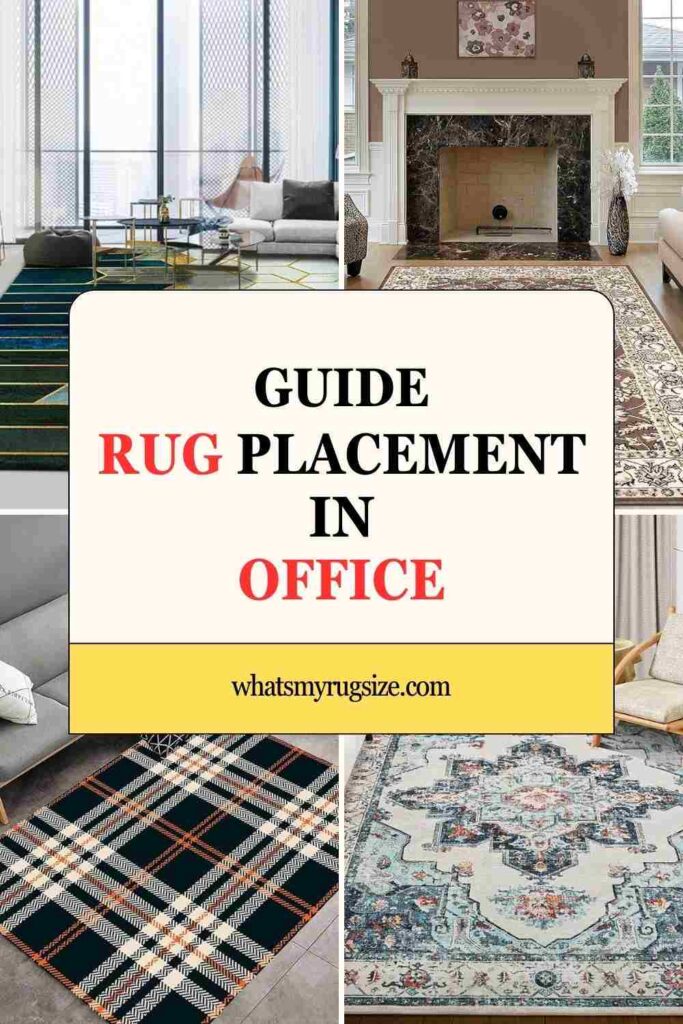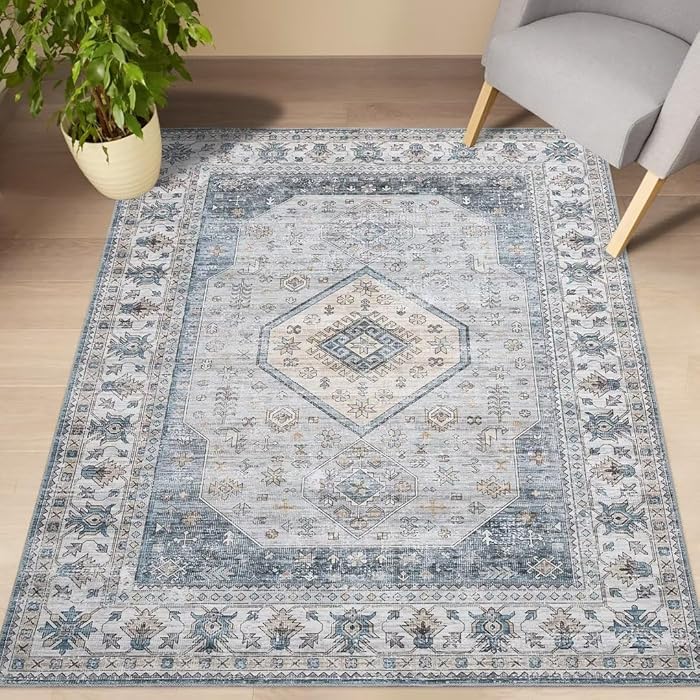Rugs play a bigger role in an office than most people realize. They affect comfort, sound, and the way the space looks. A well-placed rug can make an office feel organized, grounded, and professional. A poorly sized or misplaced rug can throw off the balance of the entire room.
Choosing the right size and layout requires planning. This guide covers how to measure, place, and use rugs in different office layouts.
Why Rugs Matter in an Office?
A rug in an office is more than decoration. It defines space. It softens hard flooring, helps reduce noise, and creates a warm surface underfoot. Many offices have desks, chairs, cabinets, and electronics spread across the floor. A rug pulls these elements together so the room feels intentional instead of scattered.
Another benefit is comfort. Long hours at a desk are easier when the space feels grounded and welcoming. Rugs also help reduce echo, which is especially useful in rooms with hard floors and large windows. For anyone on video calls or in meetings, better acoustics make a difference.

Measuring Before Buying
Size mistakes are common. A rug that is too small makes furniture look oversized. A rug that is too large may overwhelm the room. The key is to measure before buying.
Start by marking the intended rug space with painter’s tape on the floor. Sit in your office chair, push it back, and roll around to see how much floor space the chair covers. The rug should extend far enough so the chair does not slide off when moved. In most offices, that means at least 30 to 36 inches of rug space around the desk.
For larger offices, measure the area covered by both desk and guest chairs. If you host meetings, the rug should include the seating area as well. This prevents the awkward look of half-on, half-off furniture.
Selecting the perfect rug for your office involves more than just picking a pattern or color. One crucial aspect to consider is the size of the rug. A well-chosen rug size can tie the entire office space together, providing both visual appeal and functionality.
Standard Rug Sizes for Offices
While every office is different, some rug sizes fit common layouts.
- 5’ x 7’: Works for compact home offices with small desks. Best used under a single desk and chair setup.
- 6’ x 9’: A middle ground size. Covers a desk, chair, and some extra room for movement.
- 8’ x 10’: Suitable for medium offices. Fits a desk, rolling chair, and guest chairs in front.
- 9’ x 12’: Works for larger spaces. Often covers the full office layout, including desks, chairs, and shelving.
Oversized rugs can be cut to fit, but most people prefer standard sizes for easier handling.
Desk and Chair Placement
The desk is usually the center of an office. A rug under the desk should extend enough for the chair to roll smoothly. Stopping short makes the chair legs uneven and can wear down the rug edges.
For a centered look, place the desk and chair in the middle of the rug. If the desk is against a wall, the rug should extend past the sides and front but does not need to go behind the desk. The front legs of the desk should sit on the rug.
Guest chairs in front of the desk should also sit fully on the rug. Half-placed chairs make the space look cramped.
Conference and Meeting Areas
Offices often have a separate space for meetings. In this case, the rug defines the seating zone. The rug should extend at least 24 inches beyond all sides of the conference table. This allows chairs to slide back while still staying on the rug.
For small round tables, a rug with a circular shape can work well. The rug should be larger than the table by at least two to three feet all around.
In larger boardrooms, rectangular rugs sized 10’ x 14’ or bigger may be needed. The goal is to keep all chair legs on the rug even when people are moving.
Layering Rugs in Office Spaces
Layering can add style to an office. A large neutral rug can cover the main floor, while a smaller patterned rug defines the desk area. This works well in loft offices or studios with open layouts.
When layering, make sure the bottom rug is flat and the top rug is centered. Avoid thick rugs that may interfere with rolling chairs. Flatweave rugs are often best for layering in offices.
Materials That Work Best
Not all rugs are suited for office use. Rolling chairs and heavy desks put stress on the fibers. Durability is key.
- Low-pile wool: Strong, soft, and easy to clean. Works well for offices with moderate use.
- Nylon or polyester: Stain resistant and durable. Great for high-traffic offices.
- Flatweave cotton or synthetic blends: Affordable and easy to move. Good for layering.
- Natural fiber rugs (jute, sisal): Stylish, but rough for rolling chairs. Better as accent rugs, not main coverage.
Thick shag rugs look cozy but make it hard to move a chair smoothly. Flat, firm rugs are more practical for daily use.
Color and Pattern Choices
The rug should match the office mood. Solid neutral rugs give a clean, professional look. Darker colors hide stains but may make the room feel smaller. Lighter colors brighten a space but show wear more quickly.
Patterns can help hide marks and bring character. A subtle geometric or striped rug can add interest without being distracting. Large, bold patterns are better in creative workspaces than formal offices.
Layout Examples
| Layout Type | Rug Placement Details | Best Rug Size |
|---|---|---|
| Single Desk Office | Rug sits under desk and chair; extends at least 30 inches behind chair; rug edges extend past desk sides for balance. | 5’ x 7’ or 6’ x 9’ |
| Dual Desk Setup | One large rug under both desks; enough space for both chairs to roll back while staying on the rug. | 8’ x 10’ or larger |
| Executive Office | Desk centered on rug; guest chairs fully on rug in front; shelves and cabinets may sit off rug if needed. | 8’ x 10’ or 9’ x 12’ |
| Meeting Corner | Small round table on circular rug; rug extends 2–3 feet beyond all chairs. | 6’ round or 8’ round |
| Full Coverage | Rug covers nearly entire office floor; all furniture rests fully on rug. | 9’ x 12’ or larger |
Mistakes to Avoid
- Overlooking maintenance: Choose materials that handle office use and clean easily.
- Rug too small: Furniture looks disconnected and chair movement feels awkward.
- Edges curling: Creates tripping hazards. Use rug pads to keep corners flat.
- Thick rugs under rolling chairs: Causes friction and wear. Use low-pile instead.
- Ignoring traffic flow: Rugs should not block walkways or doors.
Rug Pads and Protection
Rug pads keep rugs from sliding and add cushioning. They also protect the floor from scratches caused by chair movement. Choose thin, non-slip pads for offices. For chairs with casters, a chair mat can be placed on top of the rug to prevent wear.
Small Office vs Large Office Needs
Small offices often need one rug that defines the desk area. Larger offices may need multiple rugs: one under the desk and another in a lounge or meeting corner. In some cases, one oversized rug that covers everything is the best choice.
Maintenance Tips
Rugs in offices collect dust, dirt, and chair marks. Regular care keeps them looking good.
- Vacuum weekly to prevent buildup.
- Rotate rugs every few months to spread wear evenly.
- Use chair mats if casters are damaging the fibers.
- Spot clean spills right away to prevent stains.
Professional cleaning once a year helps extend the life of the rug.
Conclusion
A rug can make or break the feel of an office. The right size creates balance, and the right layout adds structure. Whether working from a compact home office or managing a larger executive space, rug placement shapes the way the room functions. Measuring carefully, choosing practical materials, and planning the layout ensures a professional space that feels comfortable and polished.

I am Zuhe Honorata Ejsmont, I have over 8 years of experience working with rugs and carpets, and I enjoy sharing what I’ve learned through my blog. I’m passionate about helping people find the perfect rug to fit their style and needs. I focus on clear, easy-to-understand advice about different materials, designs, and care tips.
Currently, I serve as a co-founder of WhatsMyRugsize.com. When I’m not writing, I love exploring local markets to discover unique rugs and adding new touches to my own home.


